Audit Planning and Control: Trunkey Creek Wines Limited
VerifiedAdded on 2023/06/08
|15
|3394
|135
AI Summary
This report emphasizes the importance of audit planning and control for Trunkey Creek Wines Limited. It includes ratio analysis, business risks, and internal control mechanisms.
Contribute Materials
Your contribution can guide someone’s learning journey. Share your
documents today.
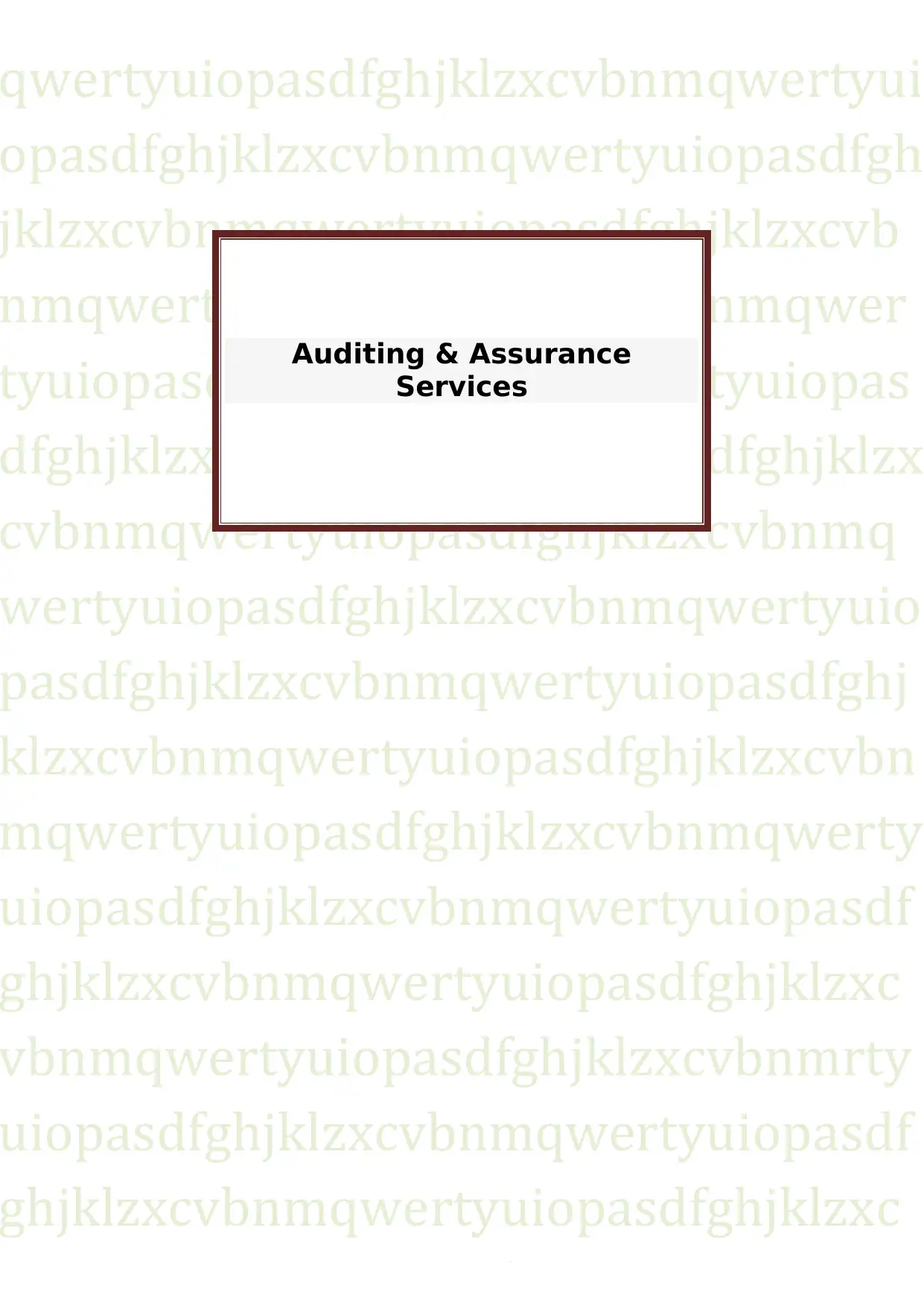
qwertyuiopasdfghjklzxcvbnmqwertyui
opasdfghjklzxcvbnmqwertyuiopasdfgh
jklzxcvbnmqwertyuiopasdfghjklzxcvb
nmqwertyuiopasdfghjklzxcvbnmqwer
tyuiopasdfghjklzxcvbnmqwertyuiopas
dfghjklzxcvbnmqwertyuiopasdfghjklzx
cvbnmqwertyuiopasdfghjklzxcvbnmq
wertyuiopasdfghjklzxcvbnmqwertyuio
pasdfghjklzxcvbnmqwertyuiopasdfghj
klzxcvbnmqwertyuiopasdfghjklzxcvbn
mqwertyuiopasdfghjklzxcvbnmqwerty
uiopasdfghjklzxcvbnmqwertyuiopasdf
ghjklzxcvbnmqwertyuiopasdfghjklzxc
vbnmqwertyuiopasdfghjklzxcvbnmrty
uiopasdfghjklzxcvbnmqwertyuiopasdf
ghjklzxcvbnmqwertyuiopasdfghjklzxc
vbnmqwertyuiopasdfghjklzxcvbnmqw
Auditing & Assurance
Services
opasdfghjklzxcvbnmqwertyuiopasdfgh
jklzxcvbnmqwertyuiopasdfghjklzxcvb
nmqwertyuiopasdfghjklzxcvbnmqwer
tyuiopasdfghjklzxcvbnmqwertyuiopas
dfghjklzxcvbnmqwertyuiopasdfghjklzx
cvbnmqwertyuiopasdfghjklzxcvbnmq
wertyuiopasdfghjklzxcvbnmqwertyuio
pasdfghjklzxcvbnmqwertyuiopasdfghj
klzxcvbnmqwertyuiopasdfghjklzxcvbn
mqwertyuiopasdfghjklzxcvbnmqwerty
uiopasdfghjklzxcvbnmqwertyuiopasdf
ghjklzxcvbnmqwertyuiopasdfghjklzxc
vbnmqwertyuiopasdfghjklzxcvbnmrty
uiopasdfghjklzxcvbnmqwertyuiopasdf
ghjklzxcvbnmqwertyuiopasdfghjklzxc
vbnmqwertyuiopasdfghjklzxcvbnmqw
Auditing & Assurance
Services
Secure Best Marks with AI Grader
Need help grading? Try our AI Grader for instant feedback on your assignments.
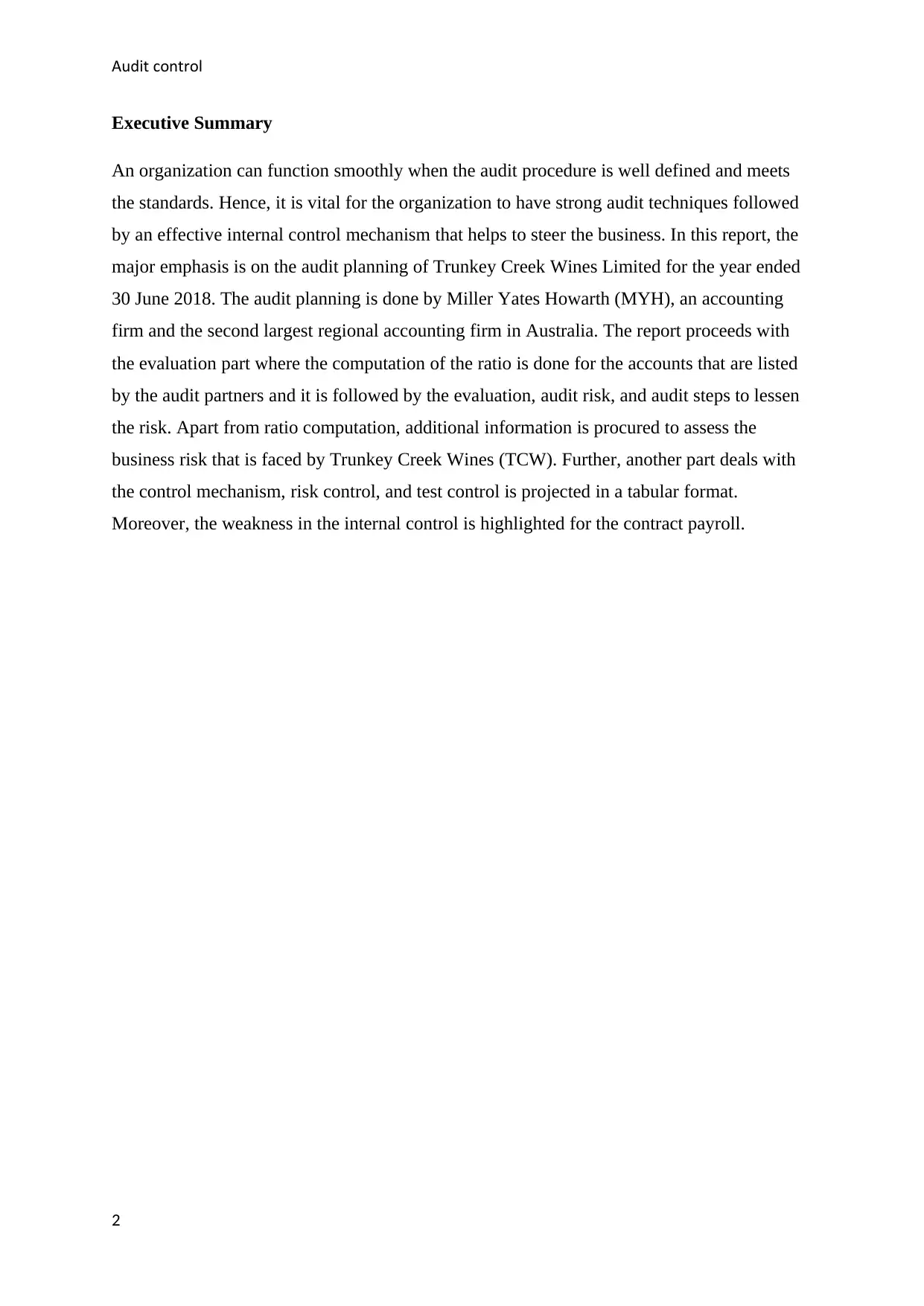
Audit control
Executive Summary
An organization can function smoothly when the audit procedure is well defined and meets
the standards. Hence, it is vital for the organization to have strong audit techniques followed
by an effective internal control mechanism that helps to steer the business. In this report, the
major emphasis is on the audit planning of Trunkey Creek Wines Limited for the year ended
30 June 2018. The audit planning is done by Miller Yates Howarth (MYH), an accounting
firm and the second largest regional accounting firm in Australia. The report proceeds with
the evaluation part where the computation of the ratio is done for the accounts that are listed
by the audit partners and it is followed by the evaluation, audit risk, and audit steps to lessen
the risk. Apart from ratio computation, additional information is procured to assess the
business risk that is faced by Trunkey Creek Wines (TCW). Further, another part deals with
the control mechanism, risk control, and test control is projected in a tabular format.
Moreover, the weakness in the internal control is highlighted for the contract payroll.
2
Executive Summary
An organization can function smoothly when the audit procedure is well defined and meets
the standards. Hence, it is vital for the organization to have strong audit techniques followed
by an effective internal control mechanism that helps to steer the business. In this report, the
major emphasis is on the audit planning of Trunkey Creek Wines Limited for the year ended
30 June 2018. The audit planning is done by Miller Yates Howarth (MYH), an accounting
firm and the second largest regional accounting firm in Australia. The report proceeds with
the evaluation part where the computation of the ratio is done for the accounts that are listed
by the audit partners and it is followed by the evaluation, audit risk, and audit steps to lessen
the risk. Apart from ratio computation, additional information is procured to assess the
business risk that is faced by Trunkey Creek Wines (TCW). Further, another part deals with
the control mechanism, risk control, and test control is projected in a tabular format.
Moreover, the weakness in the internal control is highlighted for the contract payroll.
2
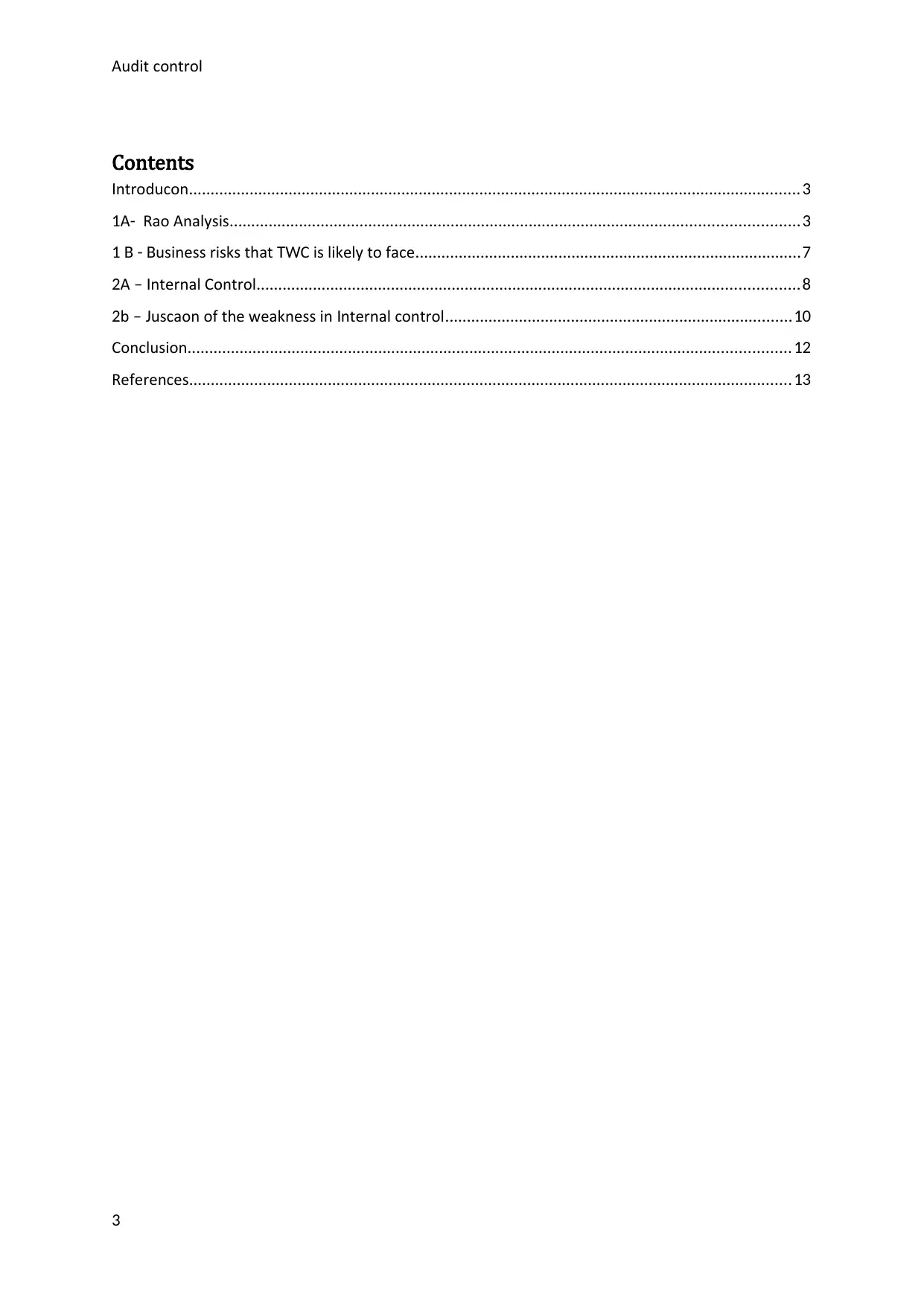
Audit control
Contents
ntroductionI .............................................................................................................................................3
A Ratio Analysis1 - ...................................................................................................................................3
usiness risks that C is likely to face1 B - B TW .........................................................................................7
A nternal Control2 – I .............................................................................................................................8
b ustification of the weakness in nternal control2 – J I ................................................................................10
Conclusion...........................................................................................................................................12
References...........................................................................................................................................13
3
Contents
ntroductionI .............................................................................................................................................3
A Ratio Analysis1 - ...................................................................................................................................3
usiness risks that C is likely to face1 B - B TW .........................................................................................7
A nternal Control2 – I .............................................................................................................................8
b ustification of the weakness in nternal control2 – J I ................................................................................10
Conclusion...........................................................................................................................................12
References...........................................................................................................................................13
3
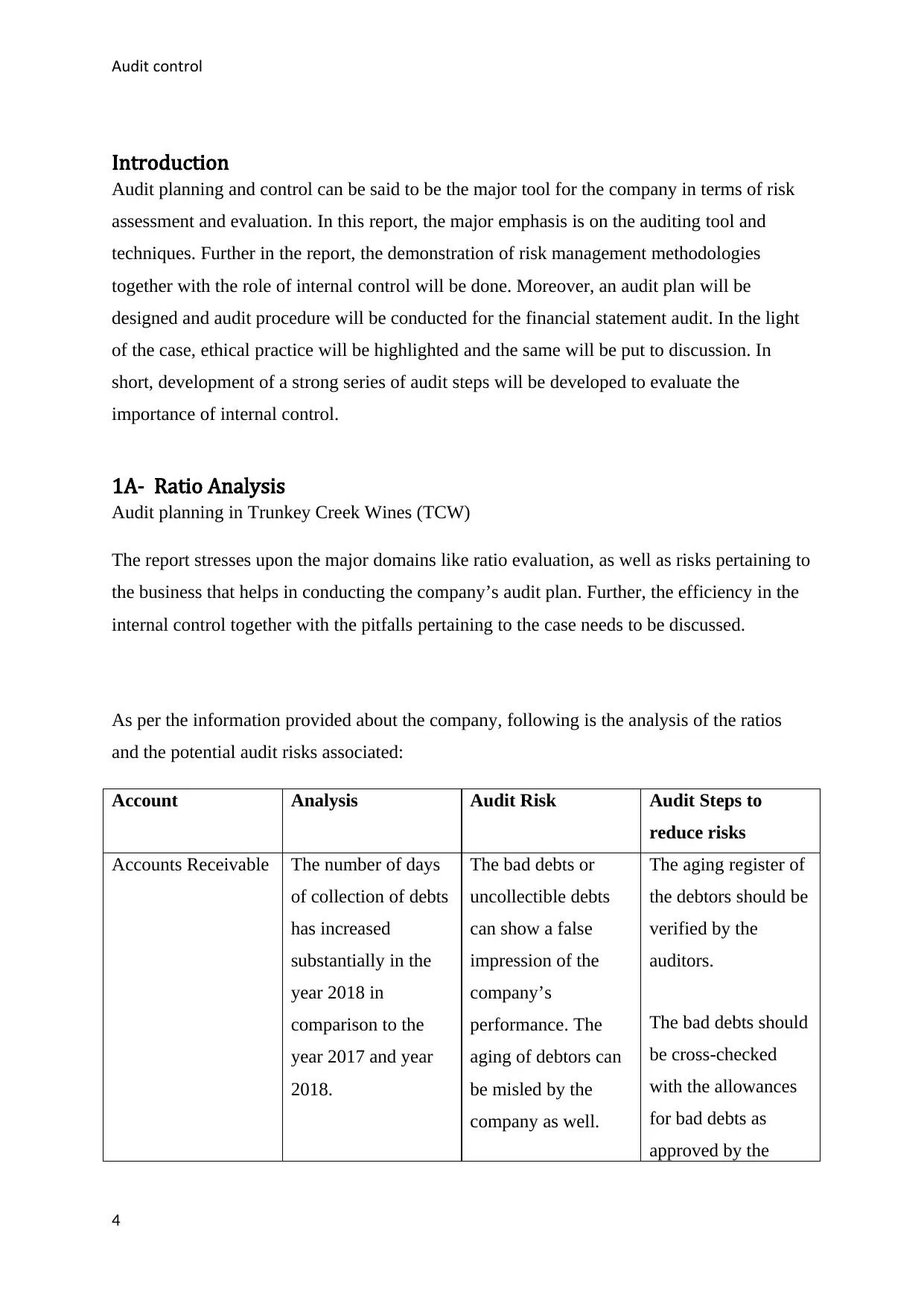
Audit control
Introduction
Audit planning and control can be said to be the major tool for the company in terms of risk
assessment and evaluation. In this report, the major emphasis is on the auditing tool and
techniques. Further in the report, the demonstration of risk management methodologies
together with the role of internal control will be done. Moreover, an audit plan will be
designed and audit procedure will be conducted for the financial statement audit. In the light
of the case, ethical practice will be highlighted and the same will be put to discussion. In
short, development of a strong series of audit steps will be developed to evaluate the
importance of internal control.
1A- Ratio Analysis
Audit planning in Trunkey Creek Wines (TCW)
The report stresses upon the major domains like ratio evaluation, as well as risks pertaining to
the business that helps in conducting the company’s audit plan. Further, the efficiency in the
internal control together with the pitfalls pertaining to the case needs to be discussed.
As per the information provided about the company, following is the analysis of the ratios
and the potential audit risks associated:
Account Analysis Audit Risk Audit Steps to
reduce risks
Accounts Receivable The number of days
of collection of debts
has increased
substantially in the
year 2018 in
comparison to the
year 2017 and year
2018.
The bad debts or
uncollectible debts
can show a false
impression of the
company’s
performance. The
aging of debtors can
be misled by the
company as well.
The aging register of
the debtors should be
verified by the
auditors.
The bad debts should
be cross-checked
with the allowances
for bad debts as
approved by the
4
Introduction
Audit planning and control can be said to be the major tool for the company in terms of risk
assessment and evaluation. In this report, the major emphasis is on the auditing tool and
techniques. Further in the report, the demonstration of risk management methodologies
together with the role of internal control will be done. Moreover, an audit plan will be
designed and audit procedure will be conducted for the financial statement audit. In the light
of the case, ethical practice will be highlighted and the same will be put to discussion. In
short, development of a strong series of audit steps will be developed to evaluate the
importance of internal control.
1A- Ratio Analysis
Audit planning in Trunkey Creek Wines (TCW)
The report stresses upon the major domains like ratio evaluation, as well as risks pertaining to
the business that helps in conducting the company’s audit plan. Further, the efficiency in the
internal control together with the pitfalls pertaining to the case needs to be discussed.
As per the information provided about the company, following is the analysis of the ratios
and the potential audit risks associated:
Account Analysis Audit Risk Audit Steps to
reduce risks
Accounts Receivable The number of days
of collection of debts
has increased
substantially in the
year 2018 in
comparison to the
year 2017 and year
2018.
The bad debts or
uncollectible debts
can show a false
impression of the
company’s
performance. The
aging of debtors can
be misled by the
company as well.
The aging register of
the debtors should be
verified by the
auditors.
The bad debts should
be cross-checked
with the allowances
for bad debts as
approved by the
4
Secure Best Marks with AI Grader
Need help grading? Try our AI Grader for instant feedback on your assignments.
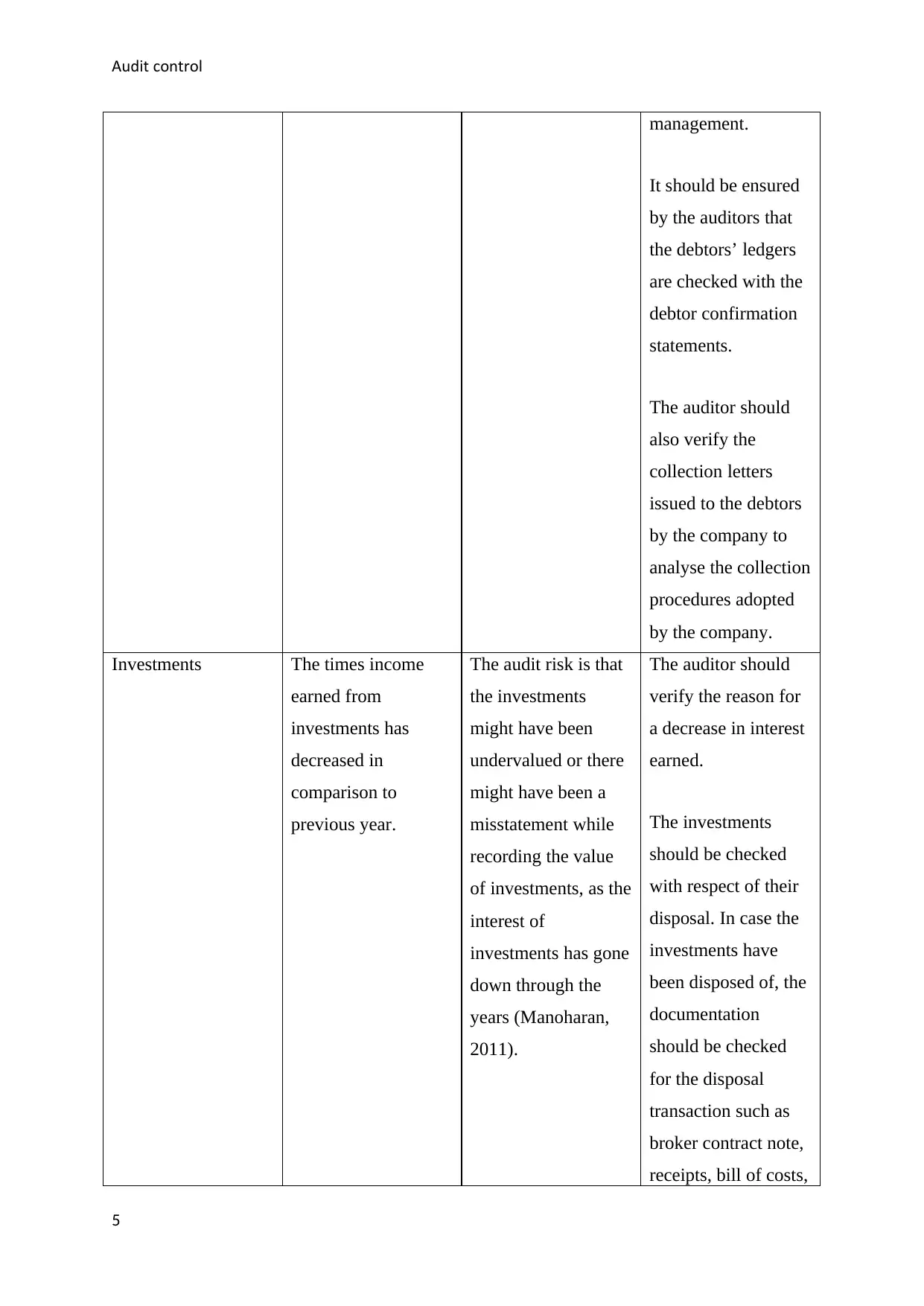
Audit control
management.
It should be ensured
by the auditors that
the debtors’ ledgers
are checked with the
debtor confirmation
statements.
The auditor should
also verify the
collection letters
issued to the debtors
by the company to
analyse the collection
procedures adopted
by the company.
Investments The times income
earned from
investments has
decreased in
comparison to
previous year.
The audit risk is that
the investments
might have been
undervalued or there
might have been a
misstatement while
recording the value
of investments, as the
interest of
investments has gone
down through the
years (Manoharan,
2011).
The auditor should
verify the reason for
a decrease in interest
earned.
The investments
should be checked
with respect of their
disposal. In case the
investments have
been disposed of, the
documentation
should be checked
for the disposal
transaction such as
broker contract note,
receipts, bill of costs,
5
management.
It should be ensured
by the auditors that
the debtors’ ledgers
are checked with the
debtor confirmation
statements.
The auditor should
also verify the
collection letters
issued to the debtors
by the company to
analyse the collection
procedures adopted
by the company.
Investments The times income
earned from
investments has
decreased in
comparison to
previous year.
The audit risk is that
the investments
might have been
undervalued or there
might have been a
misstatement while
recording the value
of investments, as the
interest of
investments has gone
down through the
years (Manoharan,
2011).
The auditor should
verify the reason for
a decrease in interest
earned.
The investments
should be checked
with respect of their
disposal. In case the
investments have
been disposed of, the
documentation
should be checked
for the disposal
transaction such as
broker contract note,
receipts, bill of costs,
5
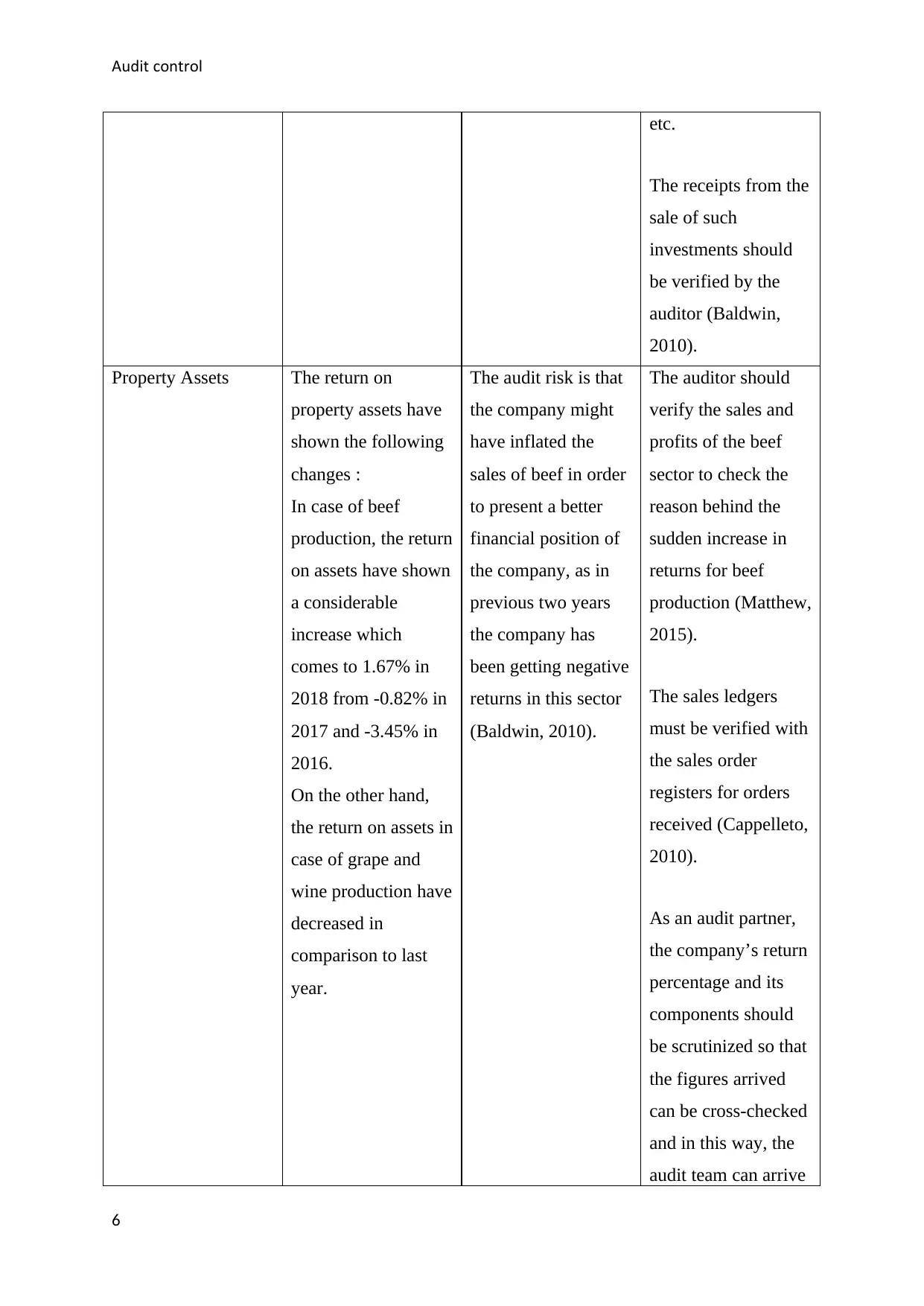
Audit control
etc.
The receipts from the
sale of such
investments should
be verified by the
auditor (Baldwin,
2010).
Property Assets The return on
property assets have
shown the following
changes :
In case of beef
production, the return
on assets have shown
a considerable
increase which
comes to 1.67% in
2018 from -0.82% in
2017 and -3.45% in
2016.
On the other hand,
the return on assets in
case of grape and
wine production have
decreased in
comparison to last
year.
The audit risk is that
the company might
have inflated the
sales of beef in order
to present a better
financial position of
the company, as in
previous two years
the company has
been getting negative
returns in this sector
(Baldwin, 2010).
The auditor should
verify the sales and
profits of the beef
sector to check the
reason behind the
sudden increase in
returns for beef
production (Matthew,
2015).
The sales ledgers
must be verified with
the sales order
registers for orders
received (Cappelleto,
2010).
As an audit partner,
the company’s return
percentage and its
components should
be scrutinized so that
the figures arrived
can be cross-checked
and in this way, the
audit team can arrive
6
etc.
The receipts from the
sale of such
investments should
be verified by the
auditor (Baldwin,
2010).
Property Assets The return on
property assets have
shown the following
changes :
In case of beef
production, the return
on assets have shown
a considerable
increase which
comes to 1.67% in
2018 from -0.82% in
2017 and -3.45% in
2016.
On the other hand,
the return on assets in
case of grape and
wine production have
decreased in
comparison to last
year.
The audit risk is that
the company might
have inflated the
sales of beef in order
to present a better
financial position of
the company, as in
previous two years
the company has
been getting negative
returns in this sector
(Baldwin, 2010).
The auditor should
verify the sales and
profits of the beef
sector to check the
reason behind the
sudden increase in
returns for beef
production (Matthew,
2015).
The sales ledgers
must be verified with
the sales order
registers for orders
received (Cappelleto,
2010).
As an audit partner,
the company’s return
percentage and its
components should
be scrutinized so that
the figures arrived
can be cross-checked
and in this way, the
audit team can arrive
6
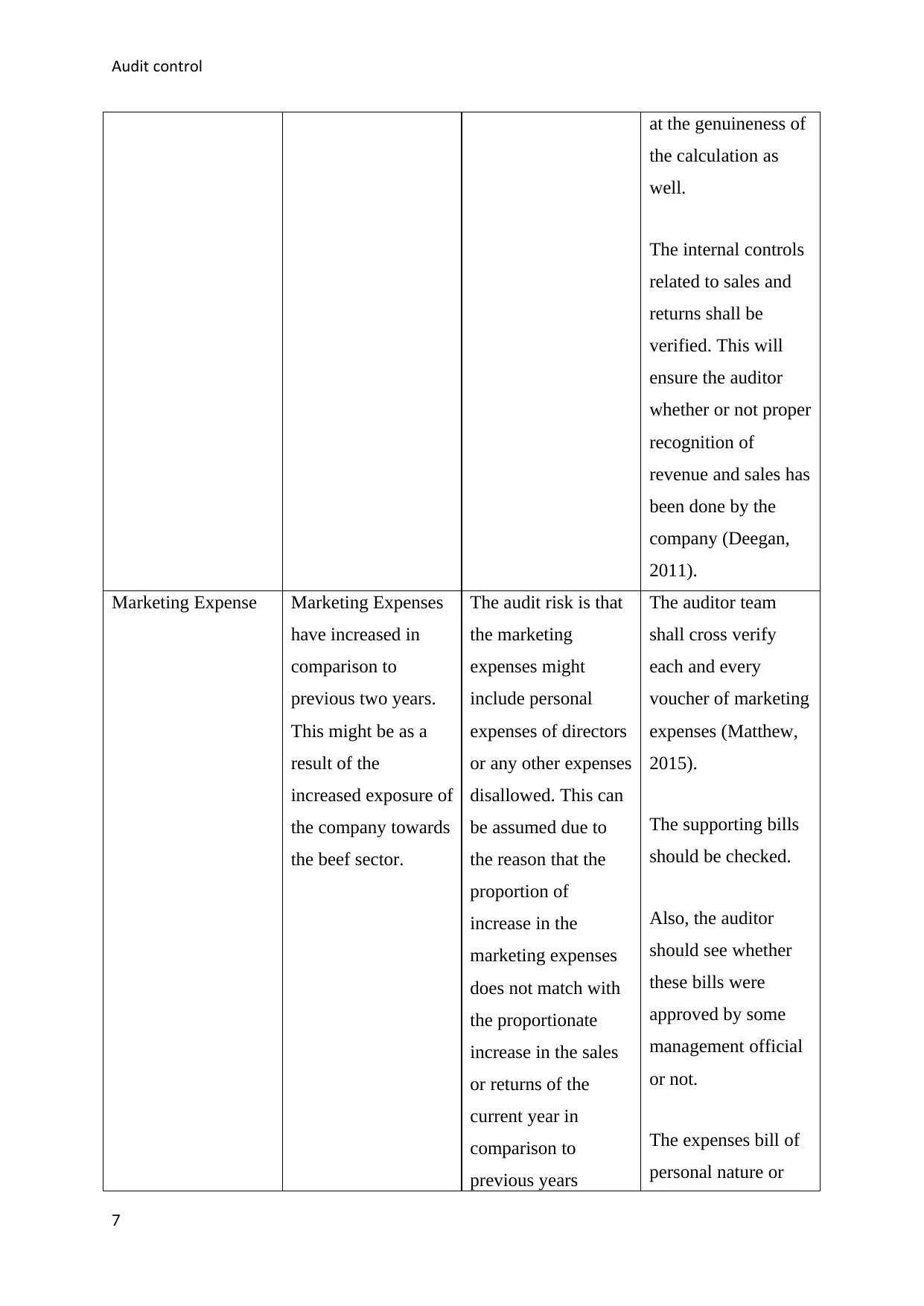
Audit control
at the genuineness of
the calculation as
well.
The internal controls
related to sales and
returns shall be
verified. This will
ensure the auditor
whether or not proper
recognition of
revenue and sales has
been done by the
company (Deegan,
2011).
Marketing Expense Marketing Expenses
have increased in
comparison to
previous two years.
This might be as a
result of the
increased exposure of
the company towards
the beef sector.
The audit risk is that
the marketing
expenses might
include personal
expenses of directors
or any other expenses
disallowed. This can
be assumed due to
the reason that the
proportion of
increase in the
marketing expenses
does not match with
the proportionate
increase in the sales
or returns of the
current year in
comparison to
previous years
The auditor team
shall cross verify
each and every
voucher of marketing
expenses (Matthew,
2015).
The supporting bills
should be checked.
Also, the auditor
should see whether
these bills were
approved by some
management official
or not.
The expenses bill of
personal nature or
7
at the genuineness of
the calculation as
well.
The internal controls
related to sales and
returns shall be
verified. This will
ensure the auditor
whether or not proper
recognition of
revenue and sales has
been done by the
company (Deegan,
2011).
Marketing Expense Marketing Expenses
have increased in
comparison to
previous two years.
This might be as a
result of the
increased exposure of
the company towards
the beef sector.
The audit risk is that
the marketing
expenses might
include personal
expenses of directors
or any other expenses
disallowed. This can
be assumed due to
the reason that the
proportion of
increase in the
marketing expenses
does not match with
the proportionate
increase in the sales
or returns of the
current year in
comparison to
previous years
The auditor team
shall cross verify
each and every
voucher of marketing
expenses (Matthew,
2015).
The supporting bills
should be checked.
Also, the auditor
should see whether
these bills were
approved by some
management official
or not.
The expenses bill of
personal nature or
7
Paraphrase This Document
Need a fresh take? Get an instant paraphrase of this document with our AI Paraphraser
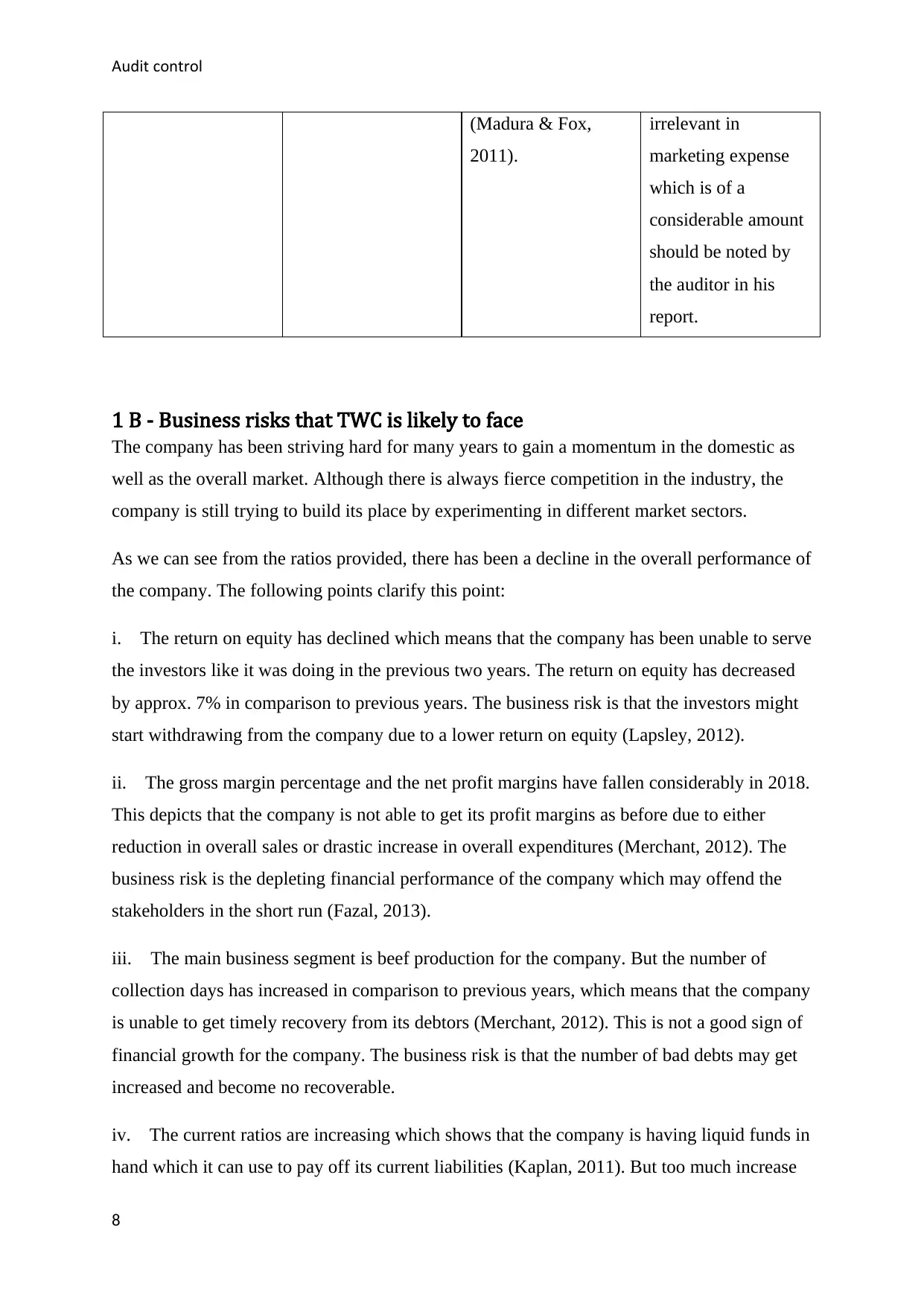
Audit control
(Madura & Fox,
2011).
irrelevant in
marketing expense
which is of a
considerable amount
should be noted by
the auditor in his
report.
1 B - Business risks that TWC is likely to face
The company has been striving hard for many years to gain a momentum in the domestic as
well as the overall market. Although there is always fierce competition in the industry, the
company is still trying to build its place by experimenting in different market sectors.
As we can see from the ratios provided, there has been a decline in the overall performance of
the company. The following points clarify this point:
i. The return on equity has declined which means that the company has been unable to serve
the investors like it was doing in the previous two years. The return on equity has decreased
by approx. 7% in comparison to previous years. The business risk is that the investors might
start withdrawing from the company due to a lower return on equity (Lapsley, 2012).
ii. The gross margin percentage and the net profit margins have fallen considerably in 2018.
This depicts that the company is not able to get its profit margins as before due to either
reduction in overall sales or drastic increase in overall expenditures (Merchant, 2012). The
business risk is the depleting financial performance of the company which may offend the
stakeholders in the short run (Fazal, 2013).
iii. The main business segment is beef production for the company. But the number of
collection days has increased in comparison to previous years, which means that the company
is unable to get timely recovery from its debtors (Merchant, 2012). This is not a good sign of
financial growth for the company. The business risk is that the number of bad debts may get
increased and become no recoverable.
iv. The current ratios are increasing which shows that the company is having liquid funds in
hand which it can use to pay off its current liabilities (Kaplan, 2011). But too much increase
8
(Madura & Fox,
2011).
irrelevant in
marketing expense
which is of a
considerable amount
should be noted by
the auditor in his
report.
1 B - Business risks that TWC is likely to face
The company has been striving hard for many years to gain a momentum in the domestic as
well as the overall market. Although there is always fierce competition in the industry, the
company is still trying to build its place by experimenting in different market sectors.
As we can see from the ratios provided, there has been a decline in the overall performance of
the company. The following points clarify this point:
i. The return on equity has declined which means that the company has been unable to serve
the investors like it was doing in the previous two years. The return on equity has decreased
by approx. 7% in comparison to previous years. The business risk is that the investors might
start withdrawing from the company due to a lower return on equity (Lapsley, 2012).
ii. The gross margin percentage and the net profit margins have fallen considerably in 2018.
This depicts that the company is not able to get its profit margins as before due to either
reduction in overall sales or drastic increase in overall expenditures (Merchant, 2012). The
business risk is the depleting financial performance of the company which may offend the
stakeholders in the short run (Fazal, 2013).
iii. The main business segment is beef production for the company. But the number of
collection days has increased in comparison to previous years, which means that the company
is unable to get timely recovery from its debtors (Merchant, 2012). This is not a good sign of
financial growth for the company. The business risk is that the number of bad debts may get
increased and become no recoverable.
iv. The current ratios are increasing which shows that the company is having liquid funds in
hand which it can use to pay off its current liabilities (Kaplan, 2011). But too much increase
8
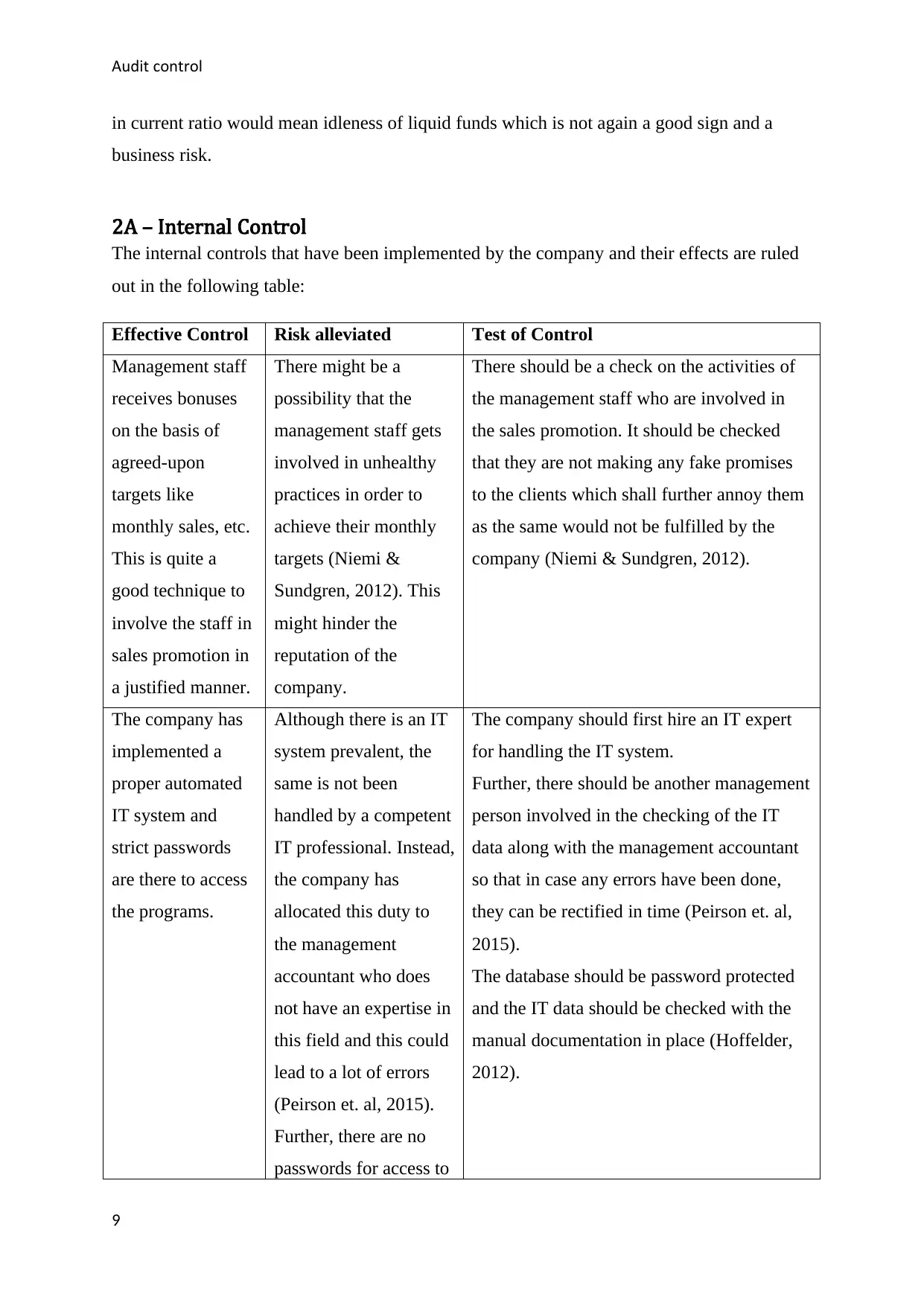
Audit control
in current ratio would mean idleness of liquid funds which is not again a good sign and a
business risk.
2A – Internal Control
The internal controls that have been implemented by the company and their effects are ruled
out in the following table:
Effective Control Risk alleviated Test of Control
Management staff
receives bonuses
on the basis of
agreed-upon
targets like
monthly sales, etc.
This is quite a
good technique to
involve the staff in
sales promotion in
a justified manner.
There might be a
possibility that the
management staff gets
involved in unhealthy
practices in order to
achieve their monthly
targets (Niemi &
Sundgren, 2012). This
might hinder the
reputation of the
company.
There should be a check on the activities of
the management staff who are involved in
the sales promotion. It should be checked
that they are not making any fake promises
to the clients which shall further annoy them
as the same would not be fulfilled by the
company (Niemi & Sundgren, 2012).
The company has
implemented a
proper automated
IT system and
strict passwords
are there to access
the programs.
Although there is an IT
system prevalent, the
same is not been
handled by a competent
IT professional. Instead,
the company has
allocated this duty to
the management
accountant who does
not have an expertise in
this field and this could
lead to a lot of errors
(Peirson et. al, 2015).
Further, there are no
passwords for access to
The company should first hire an IT expert
for handling the IT system.
Further, there should be another management
person involved in the checking of the IT
data along with the management accountant
so that in case any errors have been done,
they can be rectified in time (Peirson et. al,
2015).
The database should be password protected
and the IT data should be checked with the
manual documentation in place (Hoffelder,
2012).
9
in current ratio would mean idleness of liquid funds which is not again a good sign and a
business risk.
2A – Internal Control
The internal controls that have been implemented by the company and their effects are ruled
out in the following table:
Effective Control Risk alleviated Test of Control
Management staff
receives bonuses
on the basis of
agreed-upon
targets like
monthly sales, etc.
This is quite a
good technique to
involve the staff in
sales promotion in
a justified manner.
There might be a
possibility that the
management staff gets
involved in unhealthy
practices in order to
achieve their monthly
targets (Niemi &
Sundgren, 2012). This
might hinder the
reputation of the
company.
There should be a check on the activities of
the management staff who are involved in
the sales promotion. It should be checked
that they are not making any fake promises
to the clients which shall further annoy them
as the same would not be fulfilled by the
company (Niemi & Sundgren, 2012).
The company has
implemented a
proper automated
IT system and
strict passwords
are there to access
the programs.
Although there is an IT
system prevalent, the
same is not been
handled by a competent
IT professional. Instead,
the company has
allocated this duty to
the management
accountant who does
not have an expertise in
this field and this could
lead to a lot of errors
(Peirson et. al, 2015).
Further, there are no
passwords for access to
The company should first hire an IT expert
for handling the IT system.
Further, there should be another management
person involved in the checking of the IT
data along with the management accountant
so that in case any errors have been done,
they can be rectified in time (Peirson et. al,
2015).
The database should be password protected
and the IT data should be checked with the
manual documentation in place (Hoffelder,
2012).
9
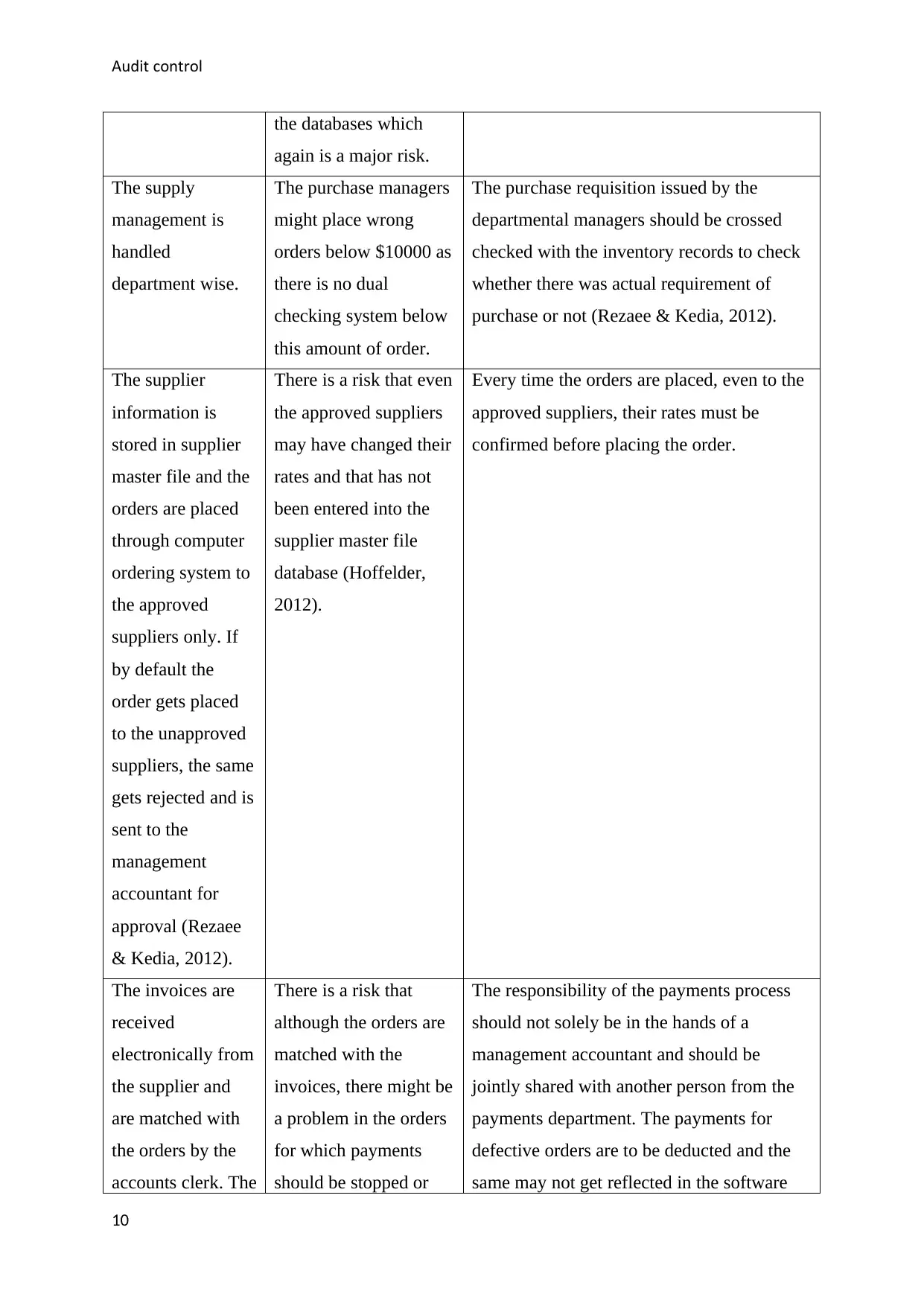
Audit control
the databases which
again is a major risk.
The supply
management is
handled
department wise.
The purchase managers
might place wrong
orders below $10000 as
there is no dual
checking system below
this amount of order.
The purchase requisition issued by the
departmental managers should be crossed
checked with the inventory records to check
whether there was actual requirement of
purchase or not (Rezaee & Kedia, 2012).
The supplier
information is
stored in supplier
master file and the
orders are placed
through computer
ordering system to
the approved
suppliers only. If
by default the
order gets placed
to the unapproved
suppliers, the same
gets rejected and is
sent to the
management
accountant for
approval (Rezaee
& Kedia, 2012).
There is a risk that even
the approved suppliers
may have changed their
rates and that has not
been entered into the
supplier master file
database (Hoffelder,
2012).
Every time the orders are placed, even to the
approved suppliers, their rates must be
confirmed before placing the order.
The invoices are
received
electronically from
the supplier and
are matched with
the orders by the
accounts clerk. The
There is a risk that
although the orders are
matched with the
invoices, there might be
a problem in the orders
for which payments
should be stopped or
The responsibility of the payments process
should not solely be in the hands of a
management accountant and should be
jointly shared with another person from the
payments department. The payments for
defective orders are to be deducted and the
same may not get reflected in the software
10
the databases which
again is a major risk.
The supply
management is
handled
department wise.
The purchase managers
might place wrong
orders below $10000 as
there is no dual
checking system below
this amount of order.
The purchase requisition issued by the
departmental managers should be crossed
checked with the inventory records to check
whether there was actual requirement of
purchase or not (Rezaee & Kedia, 2012).
The supplier
information is
stored in supplier
master file and the
orders are placed
through computer
ordering system to
the approved
suppliers only. If
by default the
order gets placed
to the unapproved
suppliers, the same
gets rejected and is
sent to the
management
accountant for
approval (Rezaee
& Kedia, 2012).
There is a risk that even
the approved suppliers
may have changed their
rates and that has not
been entered into the
supplier master file
database (Hoffelder,
2012).
Every time the orders are placed, even to the
approved suppliers, their rates must be
confirmed before placing the order.
The invoices are
received
electronically from
the supplier and
are matched with
the orders by the
accounts clerk. The
There is a risk that
although the orders are
matched with the
invoices, there might be
a problem in the orders
for which payments
should be stopped or
The responsibility of the payments process
should not solely be in the hands of a
management accountant and should be
jointly shared with another person from the
payments department. The payments for
defective orders are to be deducted and the
same may not get reflected in the software
10
Secure Best Marks with AI Grader
Need help grading? Try our AI Grader for instant feedback on your assignments.
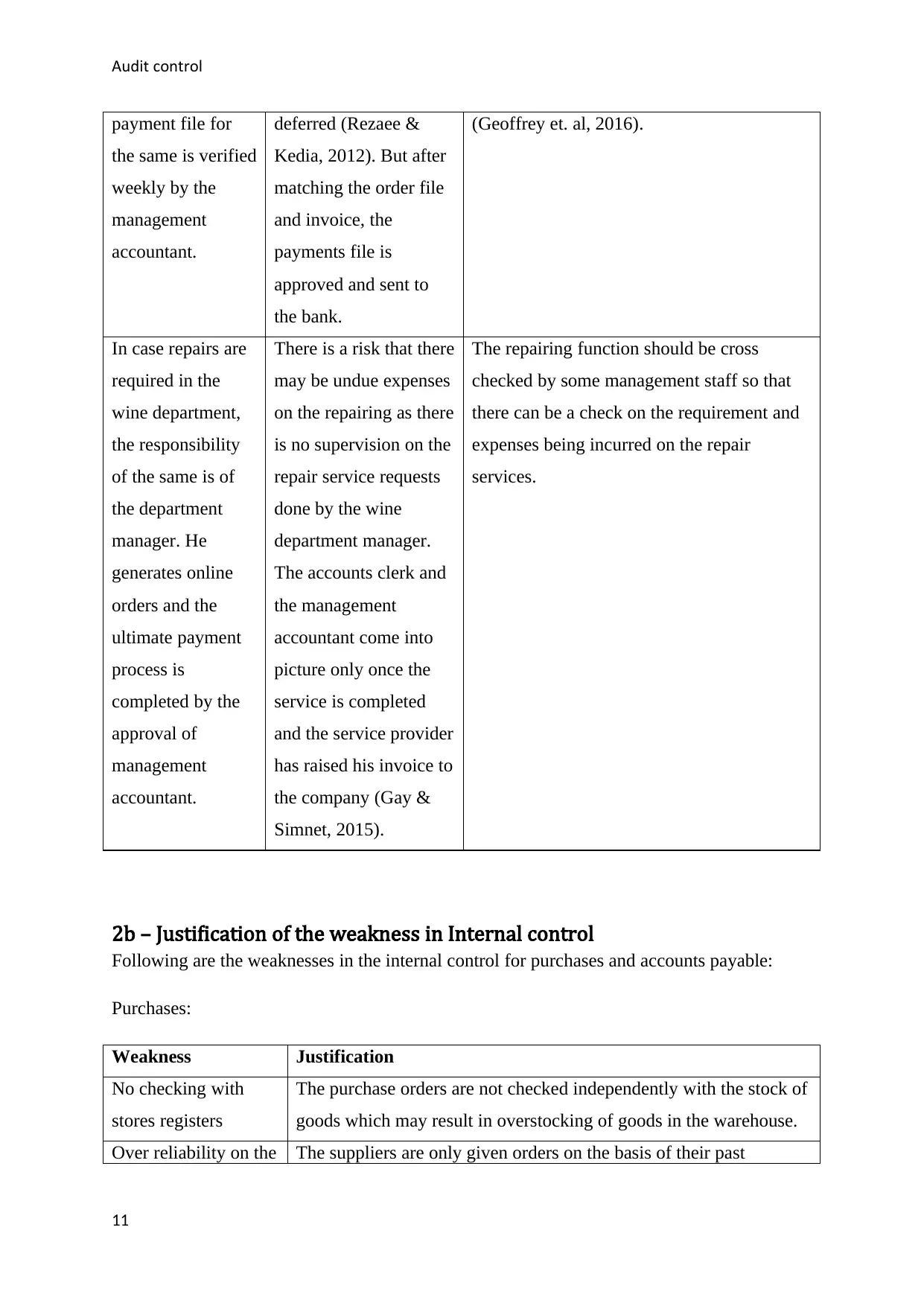
Audit control
payment file for
the same is verified
weekly by the
management
accountant.
deferred (Rezaee &
Kedia, 2012). But after
matching the order file
and invoice, the
payments file is
approved and sent to
the bank.
(Geoffrey et. al, 2016).
In case repairs are
required in the
wine department,
the responsibility
of the same is of
the department
manager. He
generates online
orders and the
ultimate payment
process is
completed by the
approval of
management
accountant.
There is a risk that there
may be undue expenses
on the repairing as there
is no supervision on the
repair service requests
done by the wine
department manager.
The accounts clerk and
the management
accountant come into
picture only once the
service is completed
and the service provider
has raised his invoice to
the company (Gay &
Simnet, 2015).
The repairing function should be cross
checked by some management staff so that
there can be a check on the requirement and
expenses being incurred on the repair
services.
2b – Justification of the weakness in Internal control
Following are the weaknesses in the internal control for purchases and accounts payable:
Purchases:
Weakness Justification
No checking with
stores registers
The purchase orders are not checked independently with the stock of
goods which may result in overstocking of goods in the warehouse.
Over reliability on the The suppliers are only given orders on the basis of their past
11
payment file for
the same is verified
weekly by the
management
accountant.
deferred (Rezaee &
Kedia, 2012). But after
matching the order file
and invoice, the
payments file is
approved and sent to
the bank.
(Geoffrey et. al, 2016).
In case repairs are
required in the
wine department,
the responsibility
of the same is of
the department
manager. He
generates online
orders and the
ultimate payment
process is
completed by the
approval of
management
accountant.
There is a risk that there
may be undue expenses
on the repairing as there
is no supervision on the
repair service requests
done by the wine
department manager.
The accounts clerk and
the management
accountant come into
picture only once the
service is completed
and the service provider
has raised his invoice to
the company (Gay &
Simnet, 2015).
The repairing function should be cross
checked by some management staff so that
there can be a check on the requirement and
expenses being incurred on the repair
services.
2b – Justification of the weakness in Internal control
Following are the weaknesses in the internal control for purchases and accounts payable:
Purchases:
Weakness Justification
No checking with
stores registers
The purchase orders are not checked independently with the stock of
goods which may result in overstocking of goods in the warehouse.
Over reliability on the The suppliers are only given orders on the basis of their past
11
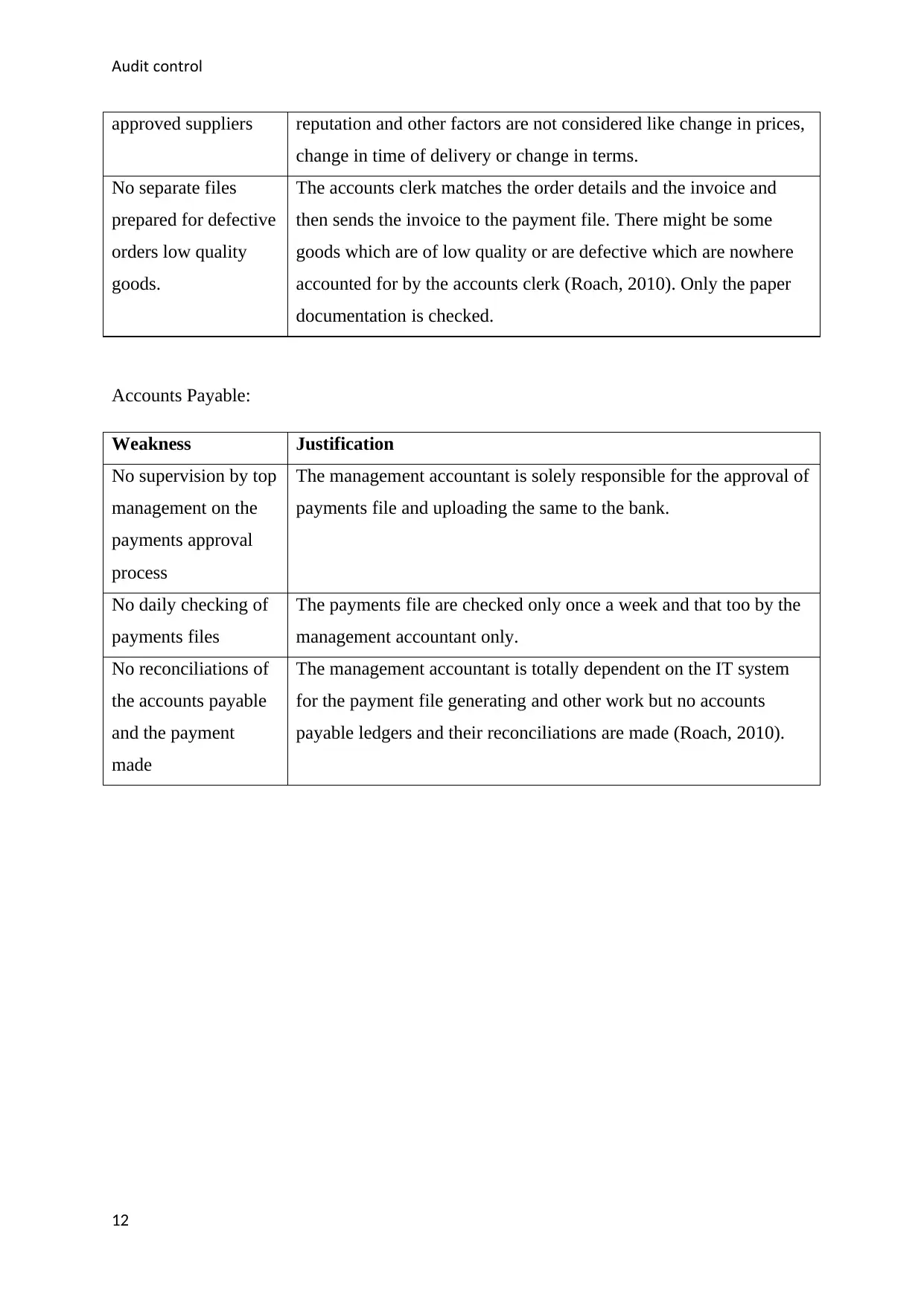
Audit control
approved suppliers reputation and other factors are not considered like change in prices,
change in time of delivery or change in terms.
No separate files
prepared for defective
orders low quality
goods.
The accounts clerk matches the order details and the invoice and
then sends the invoice to the payment file. There might be some
goods which are of low quality or are defective which are nowhere
accounted for by the accounts clerk (Roach, 2010). Only the paper
documentation is checked.
Accounts Payable:
Weakness Justification
No supervision by top
management on the
payments approval
process
The management accountant is solely responsible for the approval of
payments file and uploading the same to the bank.
No daily checking of
payments files
The payments file are checked only once a week and that too by the
management accountant only.
No reconciliations of
the accounts payable
and the payment
made
The management accountant is totally dependent on the IT system
for the payment file generating and other work but no accounts
payable ledgers and their reconciliations are made (Roach, 2010).
12
approved suppliers reputation and other factors are not considered like change in prices,
change in time of delivery or change in terms.
No separate files
prepared for defective
orders low quality
goods.
The accounts clerk matches the order details and the invoice and
then sends the invoice to the payment file. There might be some
goods which are of low quality or are defective which are nowhere
accounted for by the accounts clerk (Roach, 2010). Only the paper
documentation is checked.
Accounts Payable:
Weakness Justification
No supervision by top
management on the
payments approval
process
The management accountant is solely responsible for the approval of
payments file and uploading the same to the bank.
No daily checking of
payments files
The payments file are checked only once a week and that too by the
management accountant only.
No reconciliations of
the accounts payable
and the payment
made
The management accountant is totally dependent on the IT system
for the payment file generating and other work but no accounts
payable ledgers and their reconciliations are made (Roach, 2010).
12
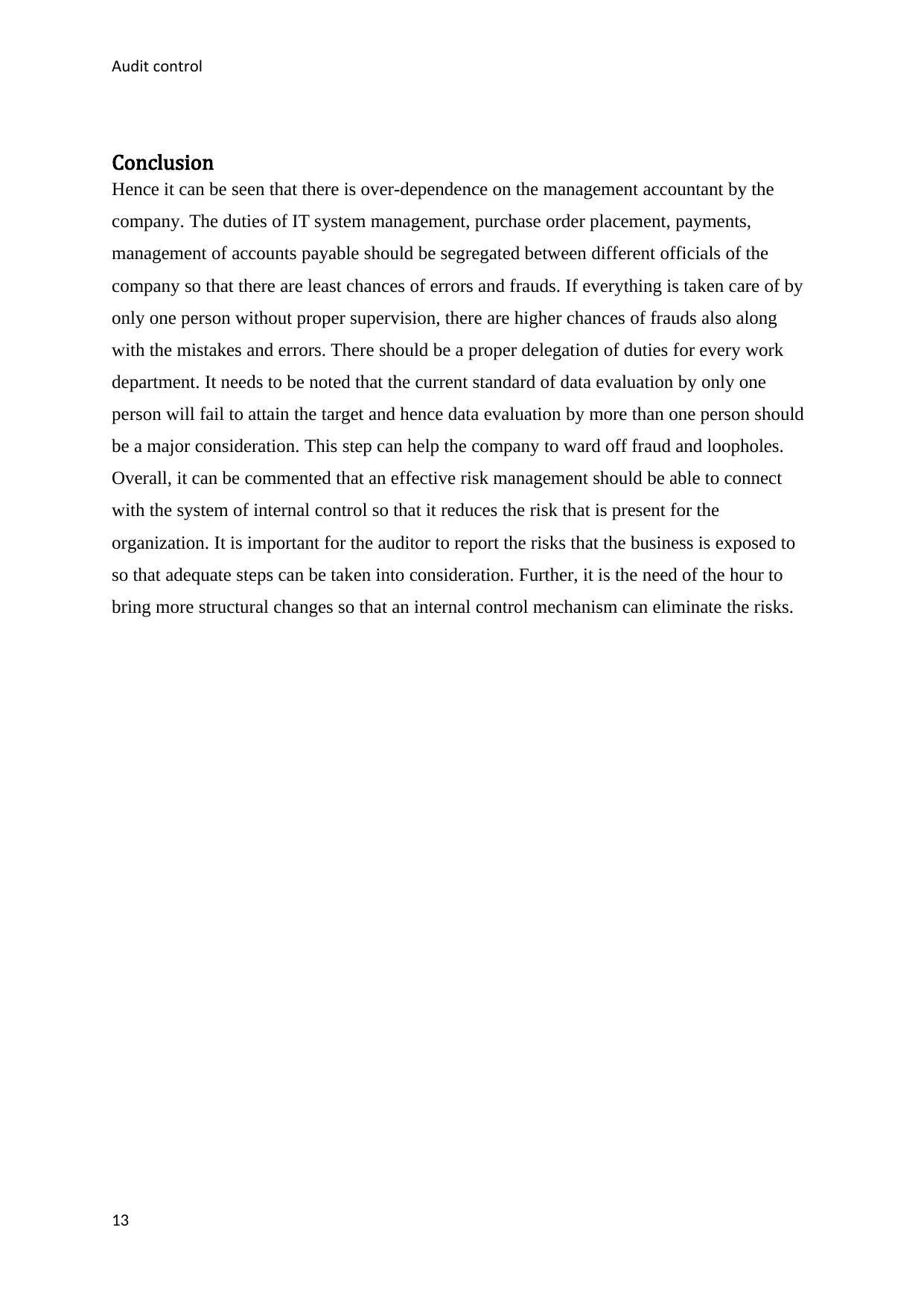
Audit control
Conclusion
Hence it can be seen that there is over-dependence on the management accountant by the
company. The duties of IT system management, purchase order placement, payments,
management of accounts payable should be segregated between different officials of the
company so that there are least chances of errors and frauds. If everything is taken care of by
only one person without proper supervision, there are higher chances of frauds also along
with the mistakes and errors. There should be a proper delegation of duties for every work
department. It needs to be noted that the current standard of data evaluation by only one
person will fail to attain the target and hence data evaluation by more than one person should
be a major consideration. This step can help the company to ward off fraud and loopholes.
Overall, it can be commented that an effective risk management should be able to connect
with the system of internal control so that it reduces the risk that is present for the
organization. It is important for the auditor to report the risks that the business is exposed to
so that adequate steps can be taken into consideration. Further, it is the need of the hour to
bring more structural changes so that an internal control mechanism can eliminate the risks.
13
Conclusion
Hence it can be seen that there is over-dependence on the management accountant by the
company. The duties of IT system management, purchase order placement, payments,
management of accounts payable should be segregated between different officials of the
company so that there are least chances of errors and frauds. If everything is taken care of by
only one person without proper supervision, there are higher chances of frauds also along
with the mistakes and errors. There should be a proper delegation of duties for every work
department. It needs to be noted that the current standard of data evaluation by only one
person will fail to attain the target and hence data evaluation by more than one person should
be a major consideration. This step can help the company to ward off fraud and loopholes.
Overall, it can be commented that an effective risk management should be able to connect
with the system of internal control so that it reduces the risk that is present for the
organization. It is important for the auditor to report the risks that the business is exposed to
so that adequate steps can be taken into consideration. Further, it is the need of the hour to
bring more structural changes so that an internal control mechanism can eliminate the risks.
13
Paraphrase This Document
Need a fresh take? Get an instant paraphrase of this document with our AI Paraphraser
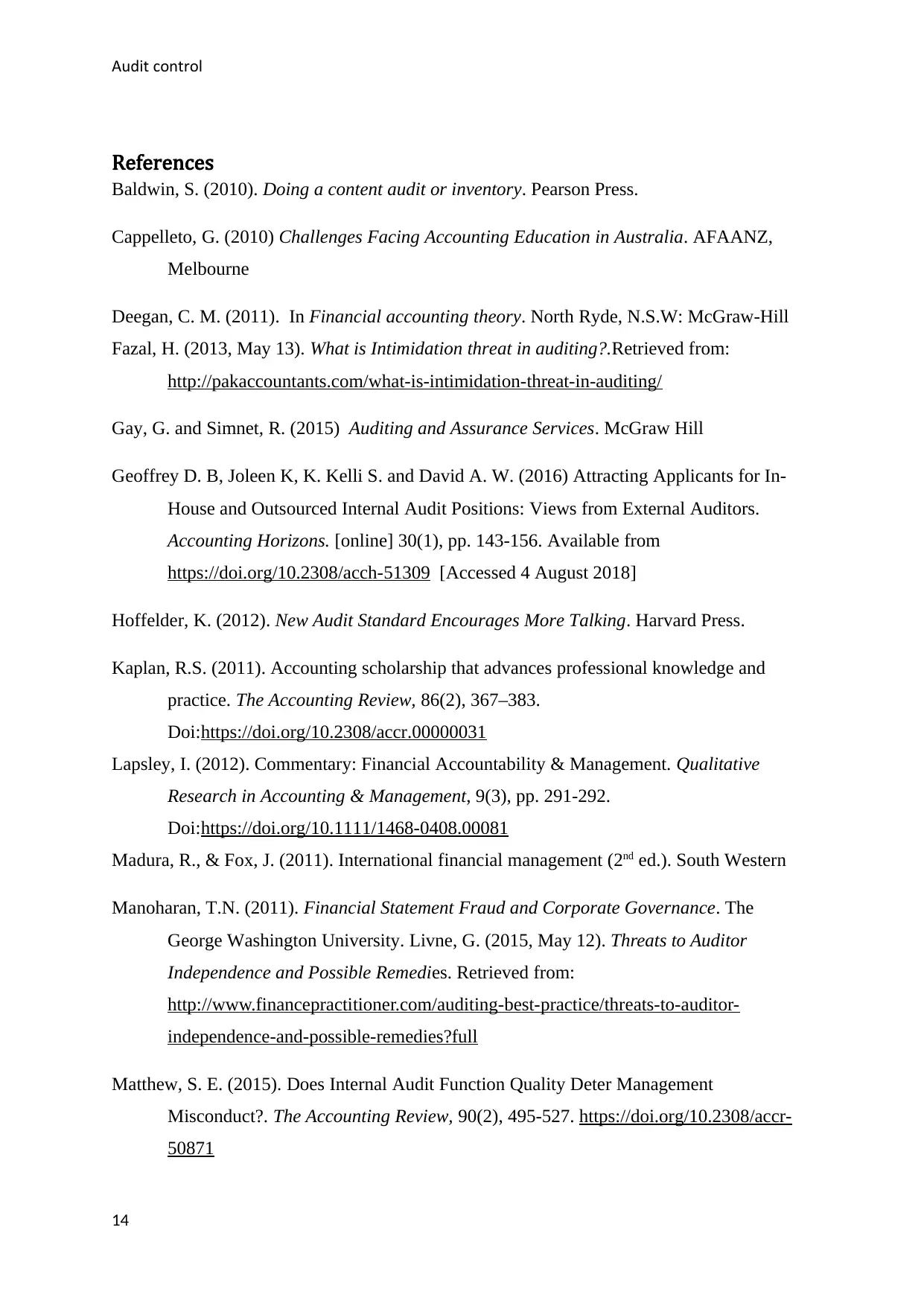
Audit control
References
Baldwin, S. (2010). Doing a content audit or inventory. Pearson Press.
Cappelleto, G. (2010) Challenges Facing Accounting Education in Australia. AFAANZ,
Melbourne
Deegan, C. M. (2011). In Financial accounting theory. North Ryde, N.S.W: McGraw-Hill
Fazal, H. (2013, May 13). What is Intimidation threat in auditing?.Retrieved from:
http://pakaccountants.com/what-is-intimidation-threat-in-auditing/
Gay, G. and Simnet, R. (2015) Auditing and Assurance Services. McGraw Hill
Geoffrey D. B, Joleen K, K. Kelli S. and David A. W. (2016) Attracting Applicants for In-
House and Outsourced Internal Audit Positions: Views from External Auditors.
Accounting Horizons. [online] 30(1), pp. 143-156. Available from
https://doi.org/10.2308/acch-51309 [Accessed 4 August 2018]
Hoffelder, K. (2012). New Audit Standard Encourages More Talking. Harvard Press.
Kaplan, R.S. (2011). Accounting scholarship that advances professional knowledge and
practice. The Accounting Review, 86(2), 367–383.
Doi:https://doi.org/10.2308/accr.00000031
Lapsley, I. (2012). Commentary: Financial Accountability & Management. Qualitative
Research in Accounting & Management, 9(3), pp. 291-292.
Doi:https://doi.org/10.1111/1468-0408.00081
Madura, R., & Fox, J. (2011). International financial management (2nd ed.). South Western
Manoharan, T.N. (2011). Financial Statement Fraud and Corporate Governance. The
George Washington University. Livne, G. (2015, May 12). Threats to Auditor
Independence and Possible Remedies. Retrieved from:
http://www.financepractitioner.com/auditing-best-practice/threats-to-auditor-
independence-and-possible-remedies?full
Matthew, S. E. (2015). Does Internal Audit Function Quality Deter Management
Misconduct?. The Accounting Review, 90(2), 495-527. https://doi.org/10.2308/accr-
50871
14
References
Baldwin, S. (2010). Doing a content audit or inventory. Pearson Press.
Cappelleto, G. (2010) Challenges Facing Accounting Education in Australia. AFAANZ,
Melbourne
Deegan, C. M. (2011). In Financial accounting theory. North Ryde, N.S.W: McGraw-Hill
Fazal, H. (2013, May 13). What is Intimidation threat in auditing?.Retrieved from:
http://pakaccountants.com/what-is-intimidation-threat-in-auditing/
Gay, G. and Simnet, R. (2015) Auditing and Assurance Services. McGraw Hill
Geoffrey D. B, Joleen K, K. Kelli S. and David A. W. (2016) Attracting Applicants for In-
House and Outsourced Internal Audit Positions: Views from External Auditors.
Accounting Horizons. [online] 30(1), pp. 143-156. Available from
https://doi.org/10.2308/acch-51309 [Accessed 4 August 2018]
Hoffelder, K. (2012). New Audit Standard Encourages More Talking. Harvard Press.
Kaplan, R.S. (2011). Accounting scholarship that advances professional knowledge and
practice. The Accounting Review, 86(2), 367–383.
Doi:https://doi.org/10.2308/accr.00000031
Lapsley, I. (2012). Commentary: Financial Accountability & Management. Qualitative
Research in Accounting & Management, 9(3), pp. 291-292.
Doi:https://doi.org/10.1111/1468-0408.00081
Madura, R., & Fox, J. (2011). International financial management (2nd ed.). South Western
Manoharan, T.N. (2011). Financial Statement Fraud and Corporate Governance. The
George Washington University. Livne, G. (2015, May 12). Threats to Auditor
Independence and Possible Remedies. Retrieved from:
http://www.financepractitioner.com/auditing-best-practice/threats-to-auditor-
independence-and-possible-remedies?full
Matthew, S. E. (2015). Does Internal Audit Function Quality Deter Management
Misconduct?. The Accounting Review, 90(2), 495-527. https://doi.org/10.2308/accr-
50871
14
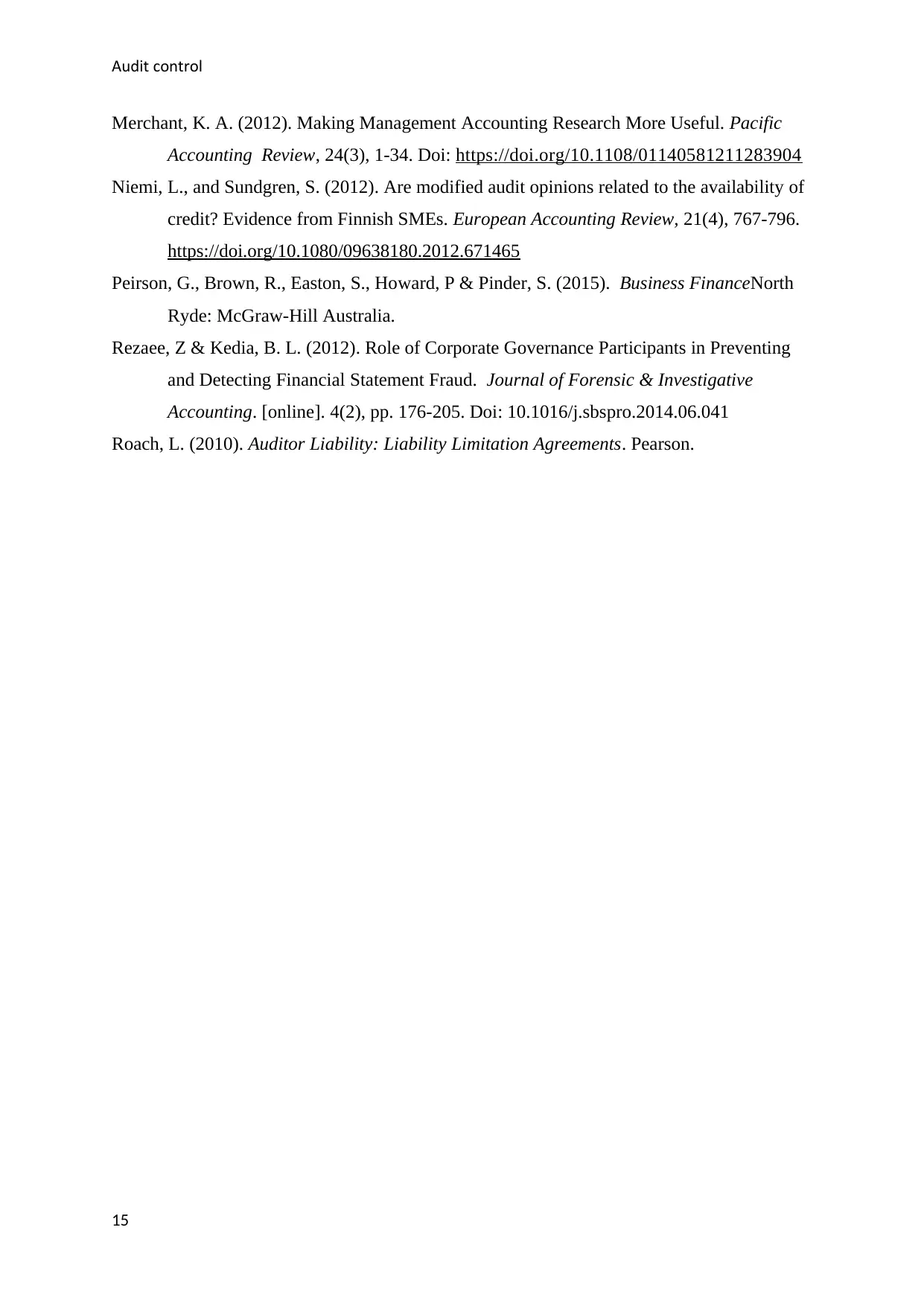
Audit control
Merchant, K. A. (2012). Making Management Accounting Research More Useful. Pacific
Accounting Review, 24(3), 1-34. Doi: https://doi.org/10.1108/01140581211283904
Niemi, L., and Sundgren, S. (2012). Are modified audit opinions related to the availability of
credit? Evidence from Finnish SMEs. European Accounting Review, 21(4), 767-796.
https://doi.org/10.1080/09638180.2012.671465
Peirson, G., Brown, R., Easton, S., Howard, P & Pinder, S. (2015). Business FinanceNorth
Ryde: McGraw-Hill Australia.
Rezaee, Z & Kedia, B. L. (2012). Role of Corporate Governance Participants in Preventing
and Detecting Financial Statement Fraud. Journal of Forensic & Investigative
Accounting. [online]. 4(2), pp. 176-205. Doi: 10.1016/j.sbspro.2014.06.041
Roach, L. (2010). Auditor Liability: Liability Limitation Agreements. Pearson.
15
Merchant, K. A. (2012). Making Management Accounting Research More Useful. Pacific
Accounting Review, 24(3), 1-34. Doi: https://doi.org/10.1108/01140581211283904
Niemi, L., and Sundgren, S. (2012). Are modified audit opinions related to the availability of
credit? Evidence from Finnish SMEs. European Accounting Review, 21(4), 767-796.
https://doi.org/10.1080/09638180.2012.671465
Peirson, G., Brown, R., Easton, S., Howard, P & Pinder, S. (2015). Business FinanceNorth
Ryde: McGraw-Hill Australia.
Rezaee, Z & Kedia, B. L. (2012). Role of Corporate Governance Participants in Preventing
and Detecting Financial Statement Fraud. Journal of Forensic & Investigative
Accounting. [online]. 4(2), pp. 176-205. Doi: 10.1016/j.sbspro.2014.06.041
Roach, L. (2010). Auditor Liability: Liability Limitation Agreements. Pearson.
15
1 out of 15
Related Documents
Your All-in-One AI-Powered Toolkit for Academic Success.
+13062052269
info@desklib.com
Available 24*7 on WhatsApp / Email
![[object Object]](/_next/static/media/star-bottom.7253800d.svg)
Unlock your academic potential
© 2024 | Zucol Services PVT LTD | All rights reserved.




